Exchange Currency
Swedish krona
The krona (plural: kronor) has been the currency of Sweden since 1873. In English, the currency is sometimes referred to as the Swedish crown, since krona literally means crown in Swedish.
One krona is subdivided into 100 öre. However, all öre coins have been discontinued as of 30 September 2010. Goods can still be priced in öre, but all sums are rounded to the nearest krona when paying with cash.
The first local Swedish coins were minted under King Olof Skotkonung around 995. During Medieval times, the Ortug, equal to 4 pennies, was the principal coin minted in Sweden. Gustav Vasa (1521-1560) introduced the large silver riksdaler, which became the basis for Swedish currency until 1873.
Sweden used large and unwieldy copper plates for money in the 1600s and 1700s. The copper plates were too heavy to be practical The Riksdaler was issued in silver (Daler Silvermynt-SED), copper (Daler Koppar Platmin-SEC) and paper (SEP) format with the exchange rates between the three fluctuating according to the value of silver, copper and the overissue of paper banknotes. The Dealer was used in Sweden until 1776.
Two accounting systems were used in Sweden according to the province with some systems based on silver money and some on copper money. The approximate values were 1 Daler equal to 6 Daler Silvermynt, 18 Daler Kopparmynt, 24 Mark, 48 Skilling, 192 Oere or 512 Oehrlein. On November 27, 1776, Gustavus III unified the systems of accounting into a single system based upon silver money with 1 Riksdaler Specie (SES) divisible into 48 Skilling or 192 Oere. Paper Daler (SEP) and Paper Riksdaler (SER) also circulated, though they usually traded at a discount to specie money. The Paper Riksdaler (SER) was subdivided into Kopparmynt Dealers, Kopparmynt Marks and Kopparmynt Oere.
The currency was reformed and devalued on June 25, 1830, and 1 Riksdaler Banco (SEB, the unit of account) was set equal to 6 silver Dealers, 48 Skilling and 192 öre. However, over-issue of Paper Riksdaler Banco (SEO) led to their steady depreciation. The currency was further reformed on February 3, 1855 and the paper Riksdaler Risk Mynt (SEM), divided now into 100 öre, was made legal tender. Silver coins were minted as a medium of exchange, but gold coins were worth their intrinsic value. The Krona (SEK) replaced the Riksdaler Riksmynt on May 30, 1873 when Sweden adopted the Gold standard and formed the Scandinavian Monetary Union (XSMK) with Denmark. Coins of Norway and Denmark were legal tender in Sweden under the Scandinavian Monetary Union, which ended de facto in 1914 and de jure in 1924. Sweden went off the Gold Standard on September 28, 1931. Sweden has not decided to adopt the Euro, to Swedish Krona will continue to circulate in Sweden after 2002.
Production of gold coins ceased in 1902 and was only briefly restarted in 1920 and 1925 before ceasing entirely. Due to metal shortages during World War I, iron replaced bronze between 1917 and 1919. Nickel-bronze replaced silver in the 10, 25 and 50 öre in 1920, with silver returning in 1927.
Metal shortages due to World War II again led to changes in the Swedish coinage. The nickel-bronze 10, 25 and 50 öre were again issued between 1940 and 1947. In 1942, iron again replaced bronze (until 1952) and the silver content of the other coins was reduced. In 1962, cupronickel replaced silver in the 10 öre, 25 öre and 50 öre coins, with the 2 kronor following suit and the 1 krona switching to cupro nickel-clad copper in 1968 (and later being replaced entirely by cupro nickel in 1982). Five-kronor silver coins were produced in 1954, 1955 and 1971, with designs similar to contemporary 1 krona and 2 kronor coins.
In 1972, a new, smaller 5 kronor coin was introduced, struck in cupro nickel-clad nickel. The current design has been produced since 1974. In 1971, the 1 and 2 öre, as well as the 2 kronor coins ceased production. The size of the 5 öre coin was reduced in 1972. In 1984, production of the 5 and 25 öre coins came to an end, followed by that of the 10 öre in 1991. Also in 1991, aluminium-brass ("Nordic gold") 10 kronor coins were introduced, along with bronze-coloured 50 öre coins.
In March 2009, the government decided to cease production of the 50 öre coins, which, since October 2010, are no longer legal tender. The reason could include low purchasing power, higher production and distribution cost than the value and the coins cannot be used in most parking machines and vending machines.
Of the other denominations issued in the past, all 2 kronor minted from 1876 onwards remain legal tender, although these are extremely rarely seen in circulation. In addition, all jubilee and commemorative coins minted in 1897 or later are also legal tender. The 2 kr coins contained 40% silver until 1966, which meant they had been for several years worth much more than 2 kr, so most have been bought and melted down by arbitrageurs, and the rest are kept by collectors.
The royal motto of the monarch is also inscribed on many of the coins. The 5 kronor coin was designed in 1974, at a time when there were political efforts to abandon the monarchy, when there was a new young inexperienced king. The monarchy remained, but the 5 kronor was not given a portrait. Coins minted before 1974 have the same size, but contain the portrait of King Gustav VI Adolf and his royal motto.
On December 18, 2008, the Swedish Riksbank announced a proposal to phase out the 50 öre, the final öre coin, by 2010. The öre would still remain a subdivision unit for electronic payments. On March 25, 2009, the Riksdag formally decided to enact the law to repeal 50 öre coins as legal tender. Under that law, the final date payments could be made with 50 öre coins was September 30, 2010. Remaining 50 öre coins could be exchanged at banks until the end of March 2011.
On 11 September 2012, the Riksbank announced a new series of coins to replace the 1 and 5 kronor coins which will be arriving in 2016. Under the theme of "Sol, vind och vatten" (English: "Sun, wind and water"), this would includes the new 2 kronor coin along the other coins. The current 10 kronor coin would remain the same. The new coins would also have a new portrait of the king in the design.
The 5 kronor bill was discontinued in 1981, although a coin had been issued since 1972. In 1985, the 500 kronor bill was introduced. With the introduction of a 10 kronor coin in 1991, production of 10 kronor bills ceased and a 20 kronor bill was introduced. Production of 50 kronor bills was suspended that year but resumed in 1996.
In 2006, the Riksbank introduced a new 1000 kronor note which is the first bill to contain the "Motion" security feature developed by Crane, then called Tumba Bruk. Crane AB, located in Tumba, Sweden, prints all of the kronor banknotes.
On 17 February 2010, the Riksbank decided to recommend the parliament to allow it to issue a 2 kronor coin and a 200 kronor note, the latter a new denomination for the country. It did not recommend replacing the 20 kronor note with a coin. The proposal accompanies the modernisation and redesigning of banknotes in Sweden. The Riksdag decision was to follow the Riksbank recommendations.
In March 2010, the Riksbank decided to decrease the sizes and weights and change the styles of the 1 krona and 5 kronor coins, still keeping the 10 kronor format. The 1 krona will be 19.5 mm, 3.6 g, and will be struck in copper-plated steel. The new 2 kronor will be 22.5 mm, 4.8 g, and will be struck in copper-plated steel. The 5 kronor will be 23.75 mm, 6.1 g, and will be struck in a Nordic gold alloy.
One krona is subdivided into 100 öre. However, all öre coins have been discontinued as of 30 September 2010. Goods can still be priced in öre, but all sums are rounded to the nearest krona when paying with cash.
Summary info
Summary information about Swedish krona- ISO 4217 Code:
- SEK
- Currency sign:
- kr
- Country:
- Sweden
- Subunit:
- öre
- Coins:
- 1 krona, 5 kronor, 10 kronor
- Banknotes:
- 20 kronor, 50 kronor, 100 kronor, 500 kronor, 1000 kronor
- Central bank:
- Sveriges Riksbank
History
The Kingdom of Sweden dates back to Medieval times. Sweden was in personal union with Norway from November 4, 1814 until June 7, 1905.The first local Swedish coins were minted under King Olof Skotkonung around 995. During Medieval times, the Ortug, equal to 4 pennies, was the principal coin minted in Sweden. Gustav Vasa (1521-1560) introduced the large silver riksdaler, which became the basis for Swedish currency until 1873.
Sweden used large and unwieldy copper plates for money in the 1600s and 1700s. The copper plates were too heavy to be practical The Riksdaler was issued in silver (Daler Silvermynt-SED), copper (Daler Koppar Platmin-SEC) and paper (SEP) format with the exchange rates between the three fluctuating according to the value of silver, copper and the overissue of paper banknotes. The Dealer was used in Sweden until 1776.
Two accounting systems were used in Sweden according to the province with some systems based on silver money and some on copper money. The approximate values were 1 Daler equal to 6 Daler Silvermynt, 18 Daler Kopparmynt, 24 Mark, 48 Skilling, 192 Oere or 512 Oehrlein. On November 27, 1776, Gustavus III unified the systems of accounting into a single system based upon silver money with 1 Riksdaler Specie (SES) divisible into 48 Skilling or 192 Oere. Paper Daler (SEP) and Paper Riksdaler (SER) also circulated, though they usually traded at a discount to specie money. The Paper Riksdaler (SER) was subdivided into Kopparmynt Dealers, Kopparmynt Marks and Kopparmynt Oere.
The currency was reformed and devalued on June 25, 1830, and 1 Riksdaler Banco (SEB, the unit of account) was set equal to 6 silver Dealers, 48 Skilling and 192 öre. However, over-issue of Paper Riksdaler Banco (SEO) led to their steady depreciation. The currency was further reformed on February 3, 1855 and the paper Riksdaler Risk Mynt (SEM), divided now into 100 öre, was made legal tender. Silver coins were minted as a medium of exchange, but gold coins were worth their intrinsic value. The Krona (SEK) replaced the Riksdaler Riksmynt on May 30, 1873 when Sweden adopted the Gold standard and formed the Scandinavian Monetary Union (XSMK) with Denmark. Coins of Norway and Denmark were legal tender in Sweden under the Scandinavian Monetary Union, which ended de facto in 1914 and de jure in 1924. Sweden went off the Gold Standard on September 28, 1931. Sweden has not decided to adopt the Euro, to Swedish Krona will continue to circulate in Sweden after 2002.
Coins
Between 1873 and 1876, coins in denominations of 1, 2, 5, 10, 25, and 50 öre and 1, 2, 10, and 20 kronor were introduced, with the 1, 2 and 5 öre in bronze, the 10, 25, 50 öre and 1 krona and 2 kronor in silver, and the 10 and 20 kronor in gold. Gold 5 kronor coins were added in 1881.Production of gold coins ceased in 1902 and was only briefly restarted in 1920 and 1925 before ceasing entirely. Due to metal shortages during World War I, iron replaced bronze between 1917 and 1919. Nickel-bronze replaced silver in the 10, 25 and 50 öre in 1920, with silver returning in 1927.
Metal shortages due to World War II again led to changes in the Swedish coinage. The nickel-bronze 10, 25 and 50 öre were again issued between 1940 and 1947. In 1942, iron again replaced bronze (until 1952) and the silver content of the other coins was reduced. In 1962, cupronickel replaced silver in the 10 öre, 25 öre and 50 öre coins, with the 2 kronor following suit and the 1 krona switching to cupro nickel-clad copper in 1968 (and later being replaced entirely by cupro nickel in 1982). Five-kronor silver coins were produced in 1954, 1955 and 1971, with designs similar to contemporary 1 krona and 2 kronor coins.
In 1972, a new, smaller 5 kronor coin was introduced, struck in cupro nickel-clad nickel. The current design has been produced since 1974. In 1971, the 1 and 2 öre, as well as the 2 kronor coins ceased production. The size of the 5 öre coin was reduced in 1972. In 1984, production of the 5 and 25 öre coins came to an end, followed by that of the 10 öre in 1991. Also in 1991, aluminium-brass ("Nordic gold") 10 kronor coins were introduced, along with bronze-coloured 50 öre coins.
In March 2009, the government decided to cease production of the 50 öre coins, which, since October 2010, are no longer legal tender. The reason could include low purchasing power, higher production and distribution cost than the value and the coins cannot be used in most parking machines and vending machines.
Of the other denominations issued in the past, all 2 kronor minted from 1876 onwards remain legal tender, although these are extremely rarely seen in circulation. In addition, all jubilee and commemorative coins minted in 1897 or later are also legal tender. The 2 kr coins contained 40% silver until 1966, which meant they had been for several years worth much more than 2 kr, so most have been bought and melted down by arbitrageurs, and the rest are kept by collectors.
The royal motto of the monarch is also inscribed on many of the coins. The 5 kronor coin was designed in 1974, at a time when there were political efforts to abandon the monarchy, when there was a new young inexperienced king. The monarchy remained, but the 5 kronor was not given a portrait. Coins minted before 1974 have the same size, but contain the portrait of King Gustav VI Adolf and his royal motto.
On December 18, 2008, the Swedish Riksbank announced a proposal to phase out the 50 öre, the final öre coin, by 2010. The öre would still remain a subdivision unit for electronic payments. On March 25, 2009, the Riksdag formally decided to enact the law to repeal 50 öre coins as legal tender. Under that law, the final date payments could be made with 50 öre coins was September 30, 2010. Remaining 50 öre coins could be exchanged at banks until the end of March 2011.
On 11 September 2012, the Riksbank announced a new series of coins to replace the 1 and 5 kronor coins which will be arriving in 2016. Under the theme of "Sol, vind och vatten" (English: "Sun, wind and water"), this would includes the new 2 kronor coin along the other coins. The current 10 kronor coin would remain the same. The new coins would also have a new portrait of the king in the design.
Banknotes
In 1874, notes were introduced by the Riksbank in denominations of 1 krona and 5, 10, 50, 100 and 1000 kronor. The 1 krona was only initially issued for two years, although it reappeared between 1914 and 1920. In 1939 and 1958, 10,000 kronor notes were issued.The 5 kronor bill was discontinued in 1981, although a coin had been issued since 1972. In 1985, the 500 kronor bill was introduced. With the introduction of a 10 kronor coin in 1991, production of 10 kronor bills ceased and a 20 kronor bill was introduced. Production of 50 kronor bills was suspended that year but resumed in 1996.
In 2006, the Riksbank introduced a new 1000 kronor note which is the first bill to contain the "Motion" security feature developed by Crane, then called Tumba Bruk. Crane AB, located in Tumba, Sweden, prints all of the kronor banknotes.
On 17 February 2010, the Riksbank decided to recommend the parliament to allow it to issue a 2 kronor coin and a 200 kronor note, the latter a new denomination for the country. It did not recommend replacing the 20 kronor note with a coin. The proposal accompanies the modernisation and redesigning of banknotes in Sweden. The Riksdag decision was to follow the Riksbank recommendations.
In March 2010, the Riksbank decided to decrease the sizes and weights and change the styles of the 1 krona and 5 kronor coins, still keeping the 10 kronor format. The 1 krona will be 19.5 mm, 3.6 g, and will be struck in copper-plated steel. The new 2 kronor will be 22.5 mm, 4.8 g, and will be struck in copper-plated steel. The 5 kronor will be 23.75 mm, 6.1 g, and will be struck in a Nordic gold alloy.
SEK banknotes pictures gallery
| 20 Swedish kronor | |
|---|---|
| Banknote of 20 Swedish kronor has dimensions 120×67 mm and main colors are slate gray, dark electric blue, dark lavender, manatee, anti-flash white, lavender mist, pastel brown and magnolia. The banknote of 20 Swedish kronor was issued in 2001. | |
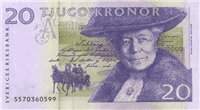 Obverse side of the 20 Swedish kronor is showing the portrait of Selma Lagerlöf (1858-1940) Värmland landscape, a brief extract from Gösta Berlings Saga and Selma Lagerlöf driving the horse carriage. |
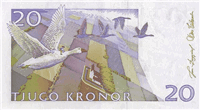 Reverse side of the 20 Swedish kronor is showing a passage motif from Selma Lagerlöf's book Nils Holgerssons Wonderful Journey through Sweden, with Nils and Mårten goose flying over the flatlands of Skåne, in southern Sweden. |
| 50 Swedish kronor | |
|---|---|
| Banknote of 50 Swedish kronor has dimensions 120×77 mm and main colors are pale gold, straw, blond, snow, wenge, pastel brown, beaver, light goldenrod yellow and pearl. The banknote of 50 Swedish kronor was issued in 2004. | |
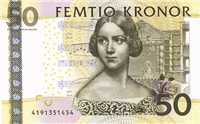 Obverse side of the 50 Swedish kronor is showing the portrait of Singer Jenny Lind, musical notes (scores) from Vincenzo Bellini's opera Norma, a drawing of Stockholm's old opera house and a rose. |
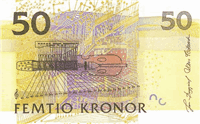 Reverse side of the 50 Swedish kronor is showing a Swedish landscape, an excerpt from the score of Sven-David Sandström's Pictures for Percussion and Orchestra, the picture of a silver harp and its tonal range. |
| 100 Swedish kronor | |
|---|---|
| Banknote of 100 Swedish kronor has dimensions 140×72 mm and main colors are pastel blue, lavender gray, timberwolf, silver, wild blue yonder, aurometalsaurus, tan, white smoke and white smoke. The banknote of 100 Swedish kronor was issued in 2006. | |
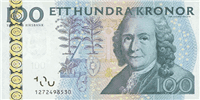 Obverse side of the 100 Swedish kronor is showing the portrait of naturalist Carl von Linné (Linnaeus) (1707-1778), a sketch of the Linnaeus garden in Uppsala, the sketches of pollinating plants taken from Linné's early work Præludia Sponsalia Rum Plantarum in 1729, the sketch of the botanical gardens in Uppsala, where Linné was director, and which is now known as the Linné garden; to the right of Linné's portrait is his motto in very small text: "OMNIA MIRARI ETIAM TRISTISSIMA" (Find wonder in all things, even the most commonplace). |
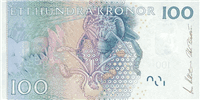 Reverse side of the 100 Swedish kronor is showing a bee pollinating a flower from a photograph by Lennart Nilsson, the stylised pictures from the fertilisation of a flower and a reconstruction of how the flower looks through the multifaceted eyes of a bee. |
| 500 Swedish kronor | |
|---|---|
| Banknote of 500 Swedish kronor has dimensions 150×82 mm and main colors are rose taupe, puce, pale chestnut, khaki, timberwolf, gainsboro, wild blue yonder, white smoke and anti-flash white. The banknote of 500 Swedish kronor was issued in 2001. | |
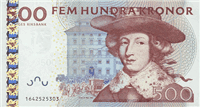 Obverse side of the 500 Swedish kronor is showing the portrait of King Carl XI - King of Sweden 1672-1697. The portrait is taken from David Klöcker Ehrenstrahl painting of 1682 which depicting Karl XI at the battle of Lund 1676 and Risk Bank's first building on Järntorget in Stockholm. |
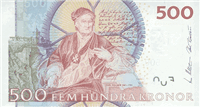 Reverse side of the 500 Swedish kronor is showing a drawing of Christopher Polhem, the father of Swedish engineering, the mathematical calculations from one of Polhemus notebooks, falun copper mine with one of Polhemus ore hauling plants and the gear wheel is from Polhemus industrial plant in Dalarna. |
| 1000 Swedish kronor | |
|---|---|
| Banknote of 1000 Swedish kronor has dimensions 160×82 mm and main colors are davy’s grey, dim gray, rosy brown, grullo, shadow, cinereous, khaki, dark gray, mint cream and white. The banknote of 1000 Swedish kronor was issued in 2006. | |
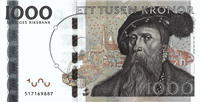 Obverse side of the 1000 Swedish kronor is showing the portrait of Gustav Vasa. |
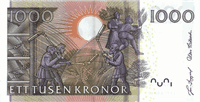 Reverse side of the 1000 Swedish kronor is showing a harvest picture from Olaus Magnus Description. |
Useful links
- About Sveriges Riksbank:
- Sveriges Riksbank
- List of currencies:
- Currencies
- Security and design features of SEK banknotes:
- SEK banknotes
- SEK currency on Wikipedia:
- Swedish krona
- Official Website of Sveriges Riksbank:
- www.riksbank.se
- Commemorative coins:
- Commemorative Coins